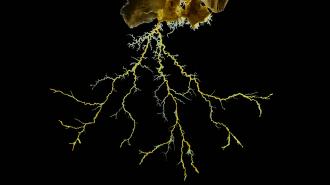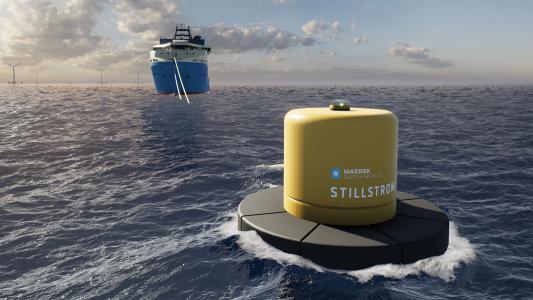Humans have always been a bit arrogant when deciding how intelligent other creatures must be. We defined humanity by our ability to make tools until Jane Goodall’s observations of chimpanzee intelligence proved that we had no monopoly on this. More amusingly, attempts to build garbage cans that are too difficult for bears to use sheds light on the overlap in intelligence between bears and many tourists.
But a recent study published in Scientific Reports suggests that there is one area where humans are at least matched by a simple slime mold: getting resources from point A to point B as efficiently — and as robustly — as possible.
Of molds and men
A slime mold is any one of a number of eukaryotic organisms known for looking like blobs of slime. The most commonly studied slime mold, Physarum polycephalum, is a “true” slime mold of the myxomycetes type. It is a single cell with many nuclei that can grow up to 0.6 meters in diameter and can move at a pace of 4 centimeters per hour.
When it grows, it creates a network of tubes growing outward from its center, reaching blindly for the nutrients in its environment.
The contractions of the tubes move nutrients about and encourage growth in areas near food, while also causing redundant sections of the network to wither. Given enough time, the slime will cover a given area with an efficient network for getting nutrients around its body.
This kind of slime is also able to accomplish rather amazing feats. For example, it can solve mazes through growth and retraction, change its structure to account for changes in resources, and even exhibit something akin to memory.
Some have proposed using the slime as a “biological computer,” as it reacts in predictable ways to external stimuli under certain conditions.
Subway slime
Building on earlier studies suggesting that the slime can design better and more robust networks than human planners, a team of researchers, led by Raphael Kay of the University of Toronto, created a computer model of Physarum polycephalum to see if it could help design urban transit systems.
The model allows for different environments to be simulated with different variables for the network, such as the overall length of the segments, the time required to travel between points, and the delays caused by removing a segment.
The model’s accuracy was confirmed by comparing it to real molds in a Petri dish, which showed that it performed remarkably similar to its real-life inspiration.
They then used the model to try recreating a portion of the Toronto metro.
The mold model was able to create a robust metro system that covered the city, with equivalent travel times, and was “about 40% less vulnerable to fault than the existing subway system” — meaning that if a segment of the system went down, it was more likely to continue operating effectively, with smaller increases in travel time.
However, the “cost” factor — determined by overall length — did find this system was more expensive. The mold model struggled to design a system with the same cost; with that parameter fixed, the vulnerability was the same and travel times were actually 10% longer than the real system.
The model did better on the more fun problem of getting people around Canada’s Wonderland — the largest theme park in Canada. The locations to travel between were based on real-life locations: rides and food stands. The slime model created a network that was 10% faster, and much more effective in the event of a segment shutting down.
The mold did much better than the designers of the amusement park, as the authors explained: “For an equivalent cost, we generated a network that was over 80% less vulnerable…and almost 10% less time-consuming…than the existing system.”
However, they noted that the park’s designers may not have built their transit system to be as efficient as possible for their own reasons.
Previous studies on this subject have shown that this kind of slime can also do a great job at figuring out how to get nutrients around a simulated map of Tokyo, with the final result looking remarkably similar to the layout of the existing Tokyo transit system.
Here is the video of how that mold did it:
Why are slime molds so good at urban planning?
Lead author Raphael Kay puts much of the mold’s relative cleverness down to having eons more time solving what is essentially a similar problem to what human planners are doing.
As he told Phys.org: “Humans aren’t the only ones dealing with the challenge of designing efficient, resilient networks. In architecture school, we were taught by human architects the lessons of past human architecture. But the slime mold has been shaped by hundreds of millions of years of evolution, so in that sense, they are far more experienced at solving certain architectural problems than we humans ever could be.”
One issue for human designers has been changing ideas of what the ideal city really looks like. Consider the utopian visions of Ebenezer Howard’s garden cities — designed to be circular, featuring wide streets radiating from the center, and connected to other similar cities by rail — and Le Corbusier’s Radiant City that features linear streets, high rises, and a shape based on the human body with an eye for industrial efficiency.
These two ideas are aimed at extremely different goals, and the cities based on these ideas look and function very differently.
Slime, however, lacks philosophy and instead optimizes for efficiency without taking detours to explore fashionable ideas. The fact that it doesn’t have to deal with existing zoning laws also means that it is free to behave exactly as it tends to without having to compromise — something few urban planners get to enjoy.
The authors of the study noted that their model can “serve as an urban design tool that offers biologically-informed rules for network construction.” Because of just how effective the systems built by Physarum can be, we may someday compare our transportation networks to those that the slime would create as a sort of benchmark for effectiveness.
Will you someday take a route to work that was slime-mold approved? Maybe. If nothing else, your local urban planners may turn to slime for a second opinion when designing new networks. (And if anybody from the Chicago Transit Authority reads this, the slime mold says to build the circle line!)
We’d love to hear from you! If you have a comment about this article or if you have a tip for a future Freethink story, please email us at [email protected].






